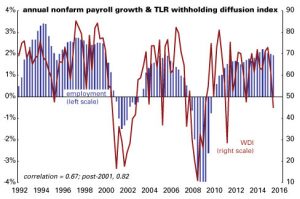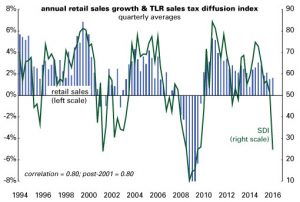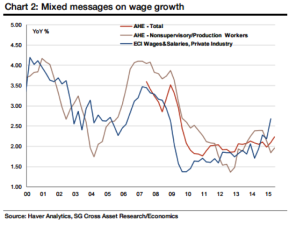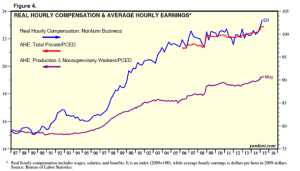About The Report
Managed by Philippa Dunne and Doug Henwood, TLR on the Economy is an independent research outfit located in New York.
Our proprietary surveys of state-level withholding and sales tax receipts are the backbone of our work. We have long-standing relationships with senior revenue estimators in tax departments around the country, whose insights give us a unique take on the state of the US economy. Instead of looking at total personal income receipts, which include non-wage income, we track withheld taxes since they are levied on wages and bonuses, not capital gains and the like.
We do our own macro-economic research, and, unlike many other research-providers, do not manage money: we are beholden to no one but our subscribers and ourselves.
Philippa Dunne and Douglas Henwood were John Liscio’s closest associates and, since John’s untimely death in 2000, are honored to be carrying on the research techniques he pioneered when he established The Liscio Report on the international scene in 1992.
We are known for our meticulous dissection of federal data, for pointing out technical anomalies glossed over in the mainstream press (and related debunking of market rumors), and for ferreting out market-moving shifts in the economic landscape as they develop, getting the news out to our readers before the mainstream media catches on. We also grill the highly informed senior tax officials who participate in our surveys on their favored indicators, like diesel-fuel consumption, and collect their thoughts on emerging economic trends for our subscribers. They are watching the cash flow into the state coffers so they know what they are talking about.
Look for us in Barron’s, the FT, Reuters, and the Wall Street Journal; on Bloomberg, Reuters, and CNBC; and around the web.
Philippa Dunne
Philippa Dunne was hired by John Liscio in 1996 to work on special projects, and in 1997 began full-time work as the “research department,” specifically to develop her own set of states for our monthly surveys of state tax collections and to handle the burgeoning demands of TLR on the Economy.
She graduated from University of California and has a Master’s Degree from Wesleyan University. A musician by training, in previous lives she has performed widely and taught at a number of colleges and private institutions, done research and writing for the Office of Ray and Charles Eames in California and for the American Museum of Natural History in New York, and, true to her name, worked in stables exercising steeplechasers. She lives in New York with her husband.
Douglas Henwood
While working toward his PhD in English at the University of Virginia, Doug returned to his earlier interest, the dismal science, and by the mid-1980s was regularly writing about the world economy with special attention to finance and the labor markets.
He caught the attention of John Liscio and as the “resident wise man” he crunched stats and analyzed them for John from the report’s very first days. A widely recognized economic analyst, Doug has given talks at venues all over the U.S. and abroad as well. He’s also frequently quoted or cited in the media, including newspapers ranging from The Asia Times to the New York Times to the Times of London.
Subscribe >








